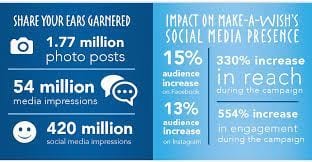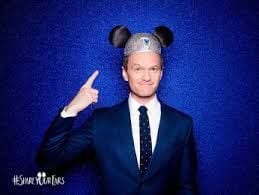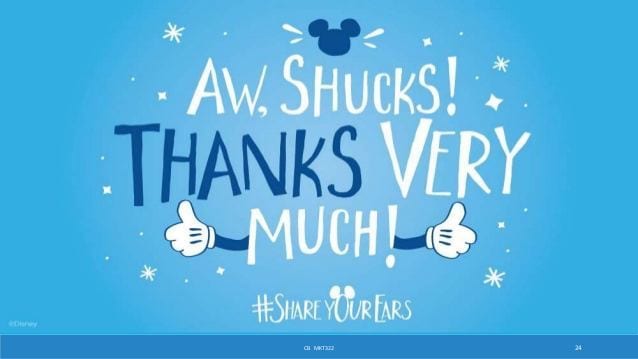Since 1981, Disney and the Make-a-Wish Foundation have been making dreams come true for children with life threatening diseases. Together, they have made over 100,000 wishes a reality! This means that Disney is involved with 1/3 of all wishes granted by Make-a-Wish. In 2015, as part of a campaign to celebrate both Disneyland’s 60th anniversary and Make-A-Wish’s 100,000th Disney-affiliated wish, the two companies decided to team up to raise money for a great cause, which was known as the Share Your Ears campaign. This would also help create a positive brand image for Disney, showing the world that they are philanthropic and that they actually do care about kids. It is extremely important for Disney to maintain that image, because it’s what their brand is built upon.
The Share Your Ears campaign is a project that Disney launched, in which they would donate $5 to Make-A-Wish for every photo shared in which the person pictured had Mickey Mouse ears and #shareyourears in the post. Originally, Disney was going to donate up to one million dollars to the cause, but due to the success of the campaign, they quickly doubled that amount to two million dollars.
This campaign was focused on social media only. They aimed the campaign at social media users on Twitter, Instagram, and Facebook as their audience, although they didn’t necessarily target any specific demographics. The results were unbelievable: over 1.7 million photos were posted with the hashtag, which resulted in over 54 million media impressions. This led to a 15% audience increase on Facebook, and a 13% audience increase on Instagram. Overall, the campaign made 420 million social media impressions. There was also a 330% increase in reach, and a 554% increase in engagement during the campaign. Disney even made roughly $150,000 in revenue from selling mouse ears during the campaign. 
Another key in the campaign’s success was celebrity endorsements. Actors such as Neil Patrick Harris joined campaign by sharing their own ears, which certainly spread awareness and helped the campaign’s publicity. These posts inspired people from all over the world to participate in the campaign.
The Share Your Ears campaign raised money for a great cause, and helped make many children’s dreams come true.
Disney’s interactive campaign was easily accessible across the world, which allowed for many people to participate from all corners of the globe. It forced audiences to interact with nonprofits such as Make-a-Wish. The campaign took off so quickly that it’s impact was immediately felt. However, I feel like Disney could have made a bigger impact by spreading its message through Snapchat, as well as launching a game or app to support the campaign. While it was a wildly successful campaign, by limiting themselves to Twitter, Facebook, and Instagram, they limited their impressions and their overall reach.
The campaign resulted in media impressions and good publicity for Disney, as well as Make-A-Wish. Two million dollars were donated for a good cause, and awareness about childhood diseases was raised. The campaign has been wildly successful, and companies seeking to improve their image as well as help the ill should consider following in Disney and Make-A-Wish’s footsteps with a similar campaign.
Check out our full case study report here, and our powerpoint presentation here.



Awesome case study! Using this is a source for another case study we’re doing here, in Toronto, at Ryerson University!
Thanks!
Hi Sanjay: Feel free to use it as a source, but know that this was put together by three freshman at Penn State for a class project! Just make sure you site all three authors!